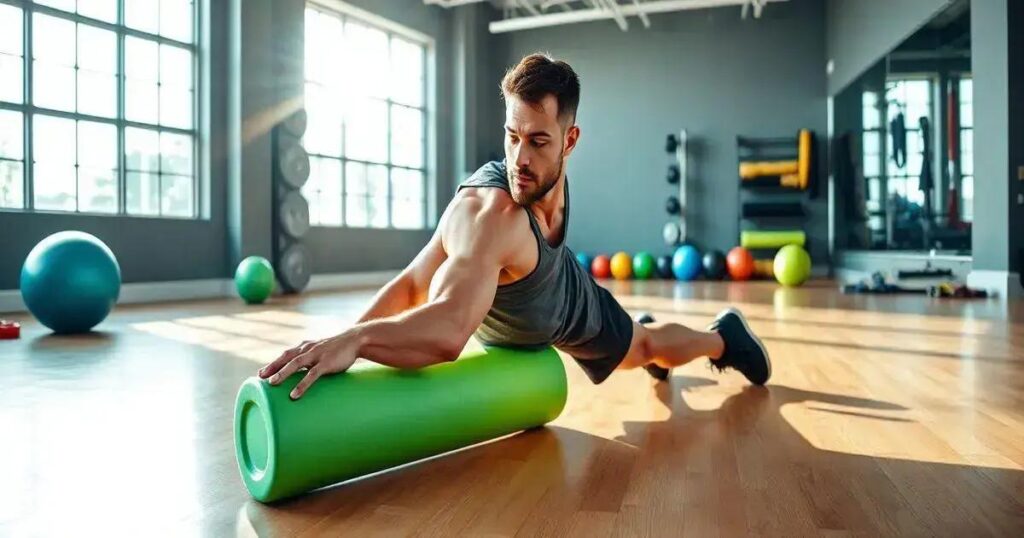Foam rollers and other recovery-focused tools are essential for men to enhance their fitness routines, reducing muscle tension, improving flexibility, and preventing injuries. Incorporating these tools into daily routines, along with proper hydration and quality sleep, leads to optimal performance and overall well-being.
Recovery is an essential part of any fitness regimen, and many men are turning to innovative tools like foam rollers to aid their recovery process. Foam rollers help relieve muscle tension, increase mobility, and prevent injuries. In this article, we will explore the key benefits of these recovery-focused tools and how men can effectively incorporate them into their fitness routines.
The Benefits of Foam Rollers for Recovery

Foam rollers have become popular tools for recovery among men looking to enhance their fitness routines. These cylindrical pieces of foam provide a method of self-myofascial release, which helps to alleviate muscle tension, improve flexibility, and speed up recovery after intense workouts.
Muscle Tension Relief
Foam rolling can significantly reduce muscle soreness and tightness. By applying pressure to tense muscles, foam rollers help release knots and trigger points, leading to a more relaxed state in the muscles. This is particularly beneficial for men who engage in rigorous physical activities or strength training.
Improved Blood Flow
Using a foam roller stimulates blood circulation, which is essential for muscle recovery. Enhanced blood flow delivers vital nutrients and oxygen to the muscles while also flushing out metabolic waste products. This process can help in reducing recovery time, allowing men to train harder and more frequently.
Enhanced Flexibility and Mobility
Regular use of foam rollers can increase both flexibility and mobility. When muscles are less tight, the body can perform movements with better range, reducing the risk of injuries during workouts. This is critical for men, especially those involved in sports that require agility and coordination.
Prevention of Injuries
By integrating foam rolling into a fitness routine, men can proactively address potential issues before they escalate into injuries. Self-myofascial release helps maintain muscle health, preventing the development of tightness that can lead to chronic pain or injuries during physical activities.
How to Use Foam Rollers Effectively

Using foam rollers effectively can transform your recovery routine. To start, choose the right foam roller for your needs. There are various densities available, so begin with a softer roller if you’re a beginner to avoid discomfort.
Finding the Right Spots
Identify the major muscle groups you want to target. Rolling out your quadriceps, hamstrings, calves, and back are essential for full-body recovery.
Proper Technique
When using a foam roller, apply your body weight onto the roller and slowly roll over each muscle group for about 30 seconds to a minute. Move at a moderate pace to allow the muscle to relax. If you find a tender spot, pause and let the pressure release.
Incorporating Breathing
During the process, focus on your breathing. Take deep breaths to help relax the muscles further as you roll. You’ll find that this deep breathing technique enhances your overall experience and increases the benefits of foam rolling.
Daily Routine Integration
Consider adding foam rolling to your daily routine. Using it before and after workouts can prepare your muscles and aid recovery. Each session only needs to take 10 to 15 minutes, making it easy to fit into any schedule.
Men’s Fitness Trends: Recovery Tools

Men’s fitness trends are increasingly focusing on recovery tools as essential components of a workout routine. Traditional workout methods mainly emphasized building strength and endurance, but today, more men are recognizing the importance of recovery to maintain performance.
Foam Rollers Leading the Way
Foam rollers are at the forefront of recovery trends. These tools help release muscle tightness and alleviate soreness after workouts. Many gyms now feature foam roller stations, promoting their use as part of a balanced fitness regimen.
Massage Guns for Targeted Relief
Another trend among men is the use of massage guns. These devices provide targeted deep tissue massage, allowing users to relieve soreness effectively. They are compact and convenient for at-home recovery, making them popular among fitness enthusiasts.
Recovery Apps and Wearable Tech
Technology is also playing a crucial role in recovery trends. Many men are using recovery tracking apps and wearable devices to monitor their muscle recovery, sleep patterns, and hydration levels. This data-driven approach helps optimize their entire fitness routines.
Yoga and Stretching Regimens
Incorporating yoga and flexibility routines into regular workouts is gaining traction. Men are discovering the benefits of stretching and yoga for improving flexibility and reducing recovery times. Classes specifically for men emphasize recovery as part of strengthening sessions.
Incorporating Recovery into Your Daily Routine

Incorporating recovery into your daily routine is essential for maintaining peak performance. Start by setting aside time for foam rolling after your workouts. Aim for at least 10-15 minutes of rolling to relieve muscle tension and promote recovery.
Morning Stretching
Begin each day with gentle stretching. This can improve flexibility and help prepare your muscles for physical activity. Consider including yoga as part of your morning routine to enhance both recovery and mental focus.
Scheduled Recovery Days
Plan recovery days into your weekly workout schedule. These days can include light activities like walking or swimming while focusing on flexibility through stretching or yoga. Prioritizing recovery helps prevent burnout and injuries.
Hydration and Nutrition
Proper hydration and nutrition are key components of recovery. Make it a habit to drink plenty of water throughout the day. Also, incorporate nutrient-rich foods into your meals, emphasizing protein and healthy fats to support muscle repair.
Sleep Hygiene
Don’t underestimate the power of quality sleep for recovery. Establish a consistent sleep schedule that allows you to get 7-9 hours of restful sleep each night. Create a bedtime routine to signal to your body that it’s time to wind down.
Incorporating Recovery Tools for Optimal Performance
In today’s fast-paced fitness world, men recognize that recovery is just as vital as training itself. Tools like foam rollers, massage guns, and recovery-focused routines help enhance physical performance and well-being.
By effectively utilizing these recovery strategies, such as foam rolling, stretching, and proper hydration, men can maintain their fitness levels and prevent injuries.
Moreover, making recovery a part of daily life, including incorporating technology and planning dedicated recovery days, can lead to long-term success in fitness journeys.
Ultimately, embracing recovery tools and techniques paves the way for better workouts and a healthier lifestyle.
FAQ – Frequently Asked Questions about Recovery Tools for Men
What are foam rollers used for?
Foam rollers are used for self-myofascial release, helping to relieve muscle tension, improve flexibility, and speed up recovery after workouts.
How often should I use a foam roller?
It’s beneficial to use a foam roller after workouts or during recovery days, aiming for at least 10-15 minutes per session.
Can foam rolling prevent injuries?
Yes, foam rolling helps maintain muscle health and prevents tightness that can lead to injuries during physical activities.
What other recovery tools can I use?
Other recovery tools include massage guns, stretching bands, and technology like recovery tracking apps and wearable devices.
How can I incorporate recovery into my routine?
Incorporate recovery by scheduling dedicated recovery days, using foam rollers daily, practicing yoga, maintaining hydration, and ensuring quality sleep.
Is recovery important for athletic performance?
Absolutely. Effective recovery is essential for enhancing performance, reducing fatigue, and preventing injury, making it a crucial aspect of any fitness regimen.












